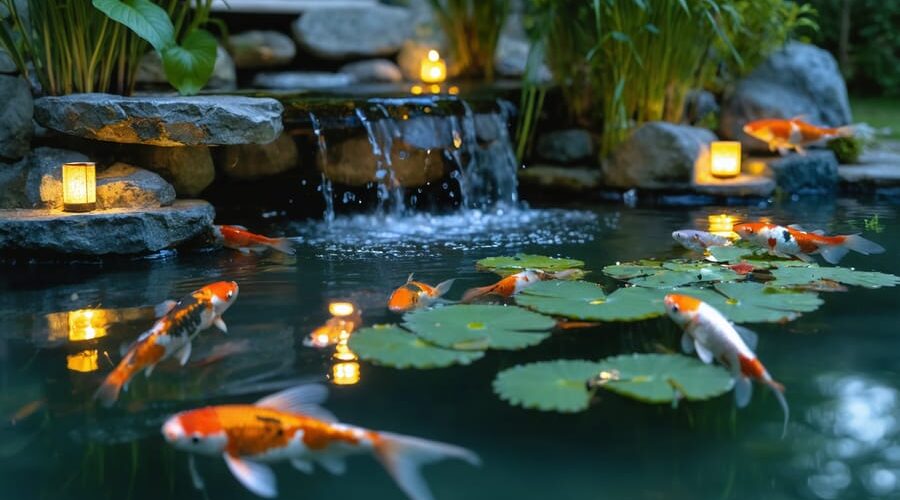
How Pond Lighting Changes Your Water’s Hidden World
Picture your pond as a tiny world where every plant, fish, and microorganism plays a vital role in keeping the water crystal clear and healthy. Understanding this underwater community isn’t just fascinating science—it’s the key to making smart lighting decisions that enhance your pond’s beauty without disrupting its delicate balance.
Here’s what most pond owners miss: the wrong lighting can trigger explosive algae growth, stress your fish, and turn your peaceful water feature into a maintenance nightmare. But when you grasp how sunlight, nutrients, and living creatures interact in your pond’s ecosystem, you’ll know exactly which lights to install, where to position them, and how long to run them.
Think of pond ecology as nature’s blueprint. Your pond naturally wants to reach equilibrium—a state where algae, beneficial bacteria, plants, and fish all coexist in harmony. Every lighting choice you make either supports this balance or throws it off. Too much light feeds algae blooms. Too little means you can’t enjoy your pond after sunset. The sweet spot? That comes from understanding what’s actually happening beneath the surface.
Whether you’re planning your first pond lighting installation or troubleshooting green water and unhappy fish, this guide connects the dots between ecological principles and practical lighting solutions. You’ll learn to work with your pond’s natural systems, not against them, creating an outdoor space that’s both stunning and sustainable.
What Makes a Pond Tick: The Basic Ecology
The Three Layers Every Pond Owner Should Know
Think of your pond as a three-story building where completely different communities live on each floor. Understanding these layers will help you place your lighting in spots that enhance rather than disrupt the natural balance.
The surface zone is where your water meets the air, and it’s buzzing with activity. This is home to floating plants like water lilies and duckweed, along with water striders skimming across the top. When you add lighting here, you’re creating a focal point that draws the eye to blooms and reflections. Surface lights work beautifully because they highlight what’s naturally meant to be seen, plus they won’t penetrate deep enough to disturb the layers below.
The middle zone is your pond’s main living room. Fish spend most of their time cruising through this area, and it’s where beneficial bacteria colonize on submerged plant stems and surfaces. Here’s where lighting gets interesting. Submersible lights placed in this zone can create stunning effects as they illuminate fish and create dancing shadows, but you need to be thoughtful. Too much light here can stress fish or encourage algae growth on every available surface.
The bottom zone is the quiet neighborhood where things slow down. Beneficial bacteria work overtime here breaking down debris, and bottom-dwelling creatures like certain snails do their cleanup work. This layer stays naturally darker, and for good reason. Heavy lighting at the bottom can disrupt these hardworking decomposers and stir up sediment, making your water cloudy.
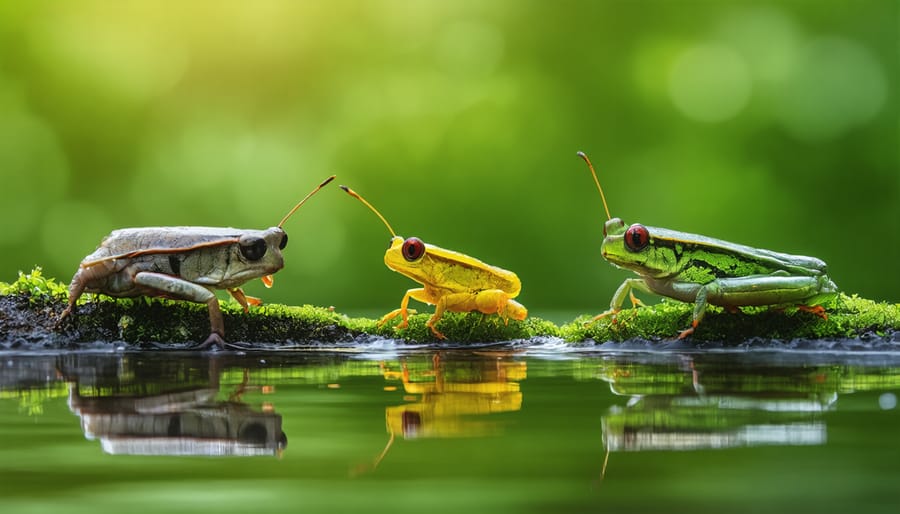
Your Pond’s Invisible Workers
Your pond is bustling with life you can’t even see. Beneath the surface, billions of beneficial bacteria and microscopic pond organisms work around the clock, breaking down fish waste, uneaten food, and decaying plant matter. These tiny heroes are the foundation of what we call the nitrogen cycle.
Here’s how it works in simple terms: fish produce ammonia through their waste, which is toxic. Beneficial bacteria convert that ammonia into nitrites, then other bacteria convert nitrites into nitrates, which are much safer and actually feed your plants. It’s nature’s perfect cleanup crew, operating 24/7 without you lifting a finger.
But here’s where lighting enters the picture. When you add pond lights, you’re not just illuminating water for your evening enjoyment. You’re potentially affecting water temperature, encouraging algae growth, and influencing the behavior of these microscopic workers. Some bacteria thrive in certain light conditions, while excessive lighting can trigger algae blooms that compete with your beneficial bacteria for resources.
Think of your pond’s bacterial community like a garden that needs balance. Too much artificial light disrupts their natural rhythm, just like leaving your kitchen lights on would confuse your houseplants. Understanding this invisible workforce helps you make smarter lighting choices that support, rather than sabotage, your pond’s natural cleaning system.
Why Light Is the Game-Changer in Your Pond
The Photosynthesis Power Hour
Here’s the thing about pond plants and algae that fascinated me when I first started my water garden—they’re basically running a 24-hour oxygen factory, but with a twist. During daylight hours, these green powerhouses absorb sunlight and carbon dioxide, then pump out oxygen through photosynthesis. It’s like having tiny air pumps working for free all day long. Your fish love this because they’re getting fresh oxygen constantly.
But here’s where it gets interesting, and why lighting matters so much. When the sun goes down, the process reverses. Plants and algae stop producing oxygen and actually start consuming it, just like your fish do. I learned this the hard way one summer when I had too much algae in my pond. During hot nights with no wind, my fish were gasping at the surface because the oxygen levels had dropped too low.
This day-night flip is why balance is everything. Too many plants or too much algae, and you might face oxygen depletion at night. Too few, and you won’t get enough natural filtration and oxygen production during the day. When you’re considering pond lighting, remember that extending “daylight” hours with bright lights can actually encourage more algae growth, shifting this delicate balance. That’s why many pond owners choose softer accent lighting that highlights their water features without triggering photosynthesis overdrive. Think of it as creating ambiance without accidentally running a plant growth lab.
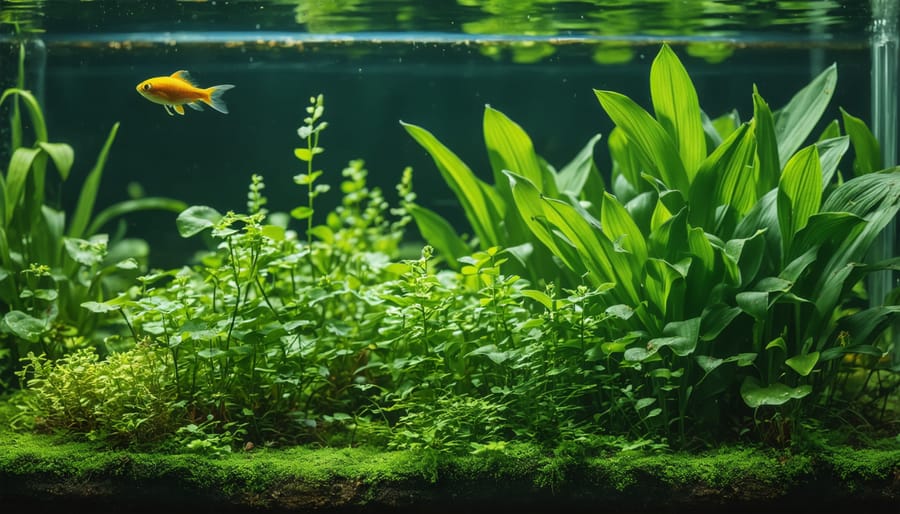
What Light Does to Your Fish and Wildlife
Your pond’s lighting doesn’t just make things pretty at night—it actually changes how your underwater residents live their lives! Let me share what I’ve learned from watching my own pond creatures react to different lighting situations.
Fish are surprisingly sensitive to light changes. In nature, they follow the sun’s rhythm, becoming more active during dawn and dusk feeding times. When you add artificial lighting, you’re essentially extending their day. I noticed my koi would keep swimming around my lights well past their normal bedtime, which seemed fun at first. But here’s the thing—fish need darkness to rest properly, just like we do. Without adequate dark periods, they can become stressed, which weakens their immune systems and makes them vulnerable to disease. The connection between fish behavior and lighting is stronger than most people realize.
Lighting also affects their feeding patterns. Bright lights can make fish feel exposed and vulnerable to predators, causing them to hide rather than feed. I’ve found that subtle, indirect lighting works better—it lets you enjoy watching them without making them feel like they’re on stage.
Your pond’s nighttime visitors matter too! Frogs rely on darkness for hunting insects, and many beneficial insects prefer dim conditions. Too much light can discourage these helpful creatures from visiting. I’ve also noticed that excessive lighting attracts moths and other flying insects, which then drown in the water, affecting your pond’s balance.
The sweet spot? Use lighting sparingly and consider timers. Your fish, frogs, and nighttime insect allies will thank you for respecting their natural rhythms while still letting you enjoy those magical evening pond moments.
The Dark Side: When Pond Lighting Goes Wrong
The Algae Explosion Nobody Wants
Here’s the thing about algae—they’re absolutely brilliant at one thing: turning light into explosive growth. And I mean explosive. I once added decorative lights to my pond thinking they’d just make it look magical at night. Within two weeks, I had what looked like green pea soup. Not exactly the aesthetic I was going for!
Algae are opportunists. When they get too much light, especially in certain color spectrums like red and blue wavelengths, they multiply like crazy. It’s not just about brightness either—duration matters hugely. Leaving your pond lights on for extended periods basically sets up an all-you-can-eat buffet for algae. They photosynthesize around the clock, outcompeting your desirable plants and throwing your pond’s entire ecosystem out of balance.
Here’s what actually triggers that green nightmare: continuous light exposure beyond 6-8 hours daily, lights positioned too close to the water surface, and those pretty blue or red accent lights that algae absolutely love. Add some warm weather and excess nutrients (fish waste, decaying leaves), and you’ve got the perfect algae explosion waiting to happen.
The good news? This is completely preventable. Use timers to limit light exposure—your fish don’t need 24-hour illumination anyway. Position lights strategically to minimize direct water contact. Consider controlling algae with UV light, which actually targets algae without disrupting your pond’s balance. And choose warmer, white-spectrum lights over those algae-feeding colors.
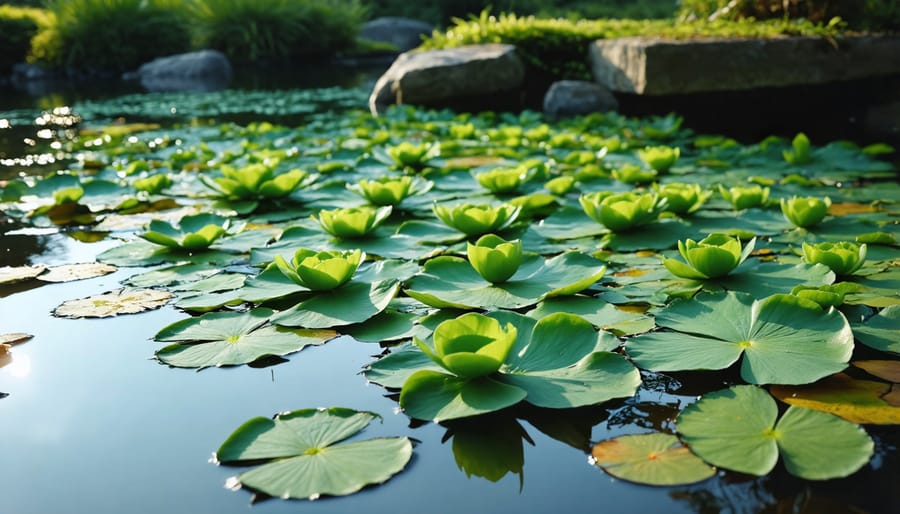
When Your Fish Stop Acting Natural
I learned this lesson the hard way when I noticed my usually playful koi hanging listlessly near the bottom of my pond. After some detective work, I realized my new underwater lights were the culprit. Fish are incredibly sensitive to light cycles, and when we mess with their natural rhythms, they show us through their behavior.
In nature, fish rely on consistent day-night patterns to regulate everything from feeding times to reproduction. When pond lights stay on too long or shine too brightly at night, fish can’t tell when it’s time to rest. Think of it like living in a room where someone keeps flipping the lights on and off randomly—you’d feel exhausted and confused too.
One of the first signs you’ll notice is disrupted sleep patterns. Fish become sluggish during the day when they should be active, or they might swim erratically at night instead of resting. I’ve watched my goldfish become noticeably agitated when evening lights stayed on past 10 PM, constantly pacing the pond perimeter instead of settling down.
Breeding behavior takes a major hit as well. Many pond fish species need specific light cues to trigger spawning. Too much artificial light confuses these signals, and you might find your fish simply won’t reproduce. I’ve talked with fellow pond keepers who wondered why their fish stopped spawning, only to discover their decorative lights were interfering with natural breeding cycles.
The stress from poor lighting doesn’t just affect behavior—it weakens immune systems. Stressed fish become vulnerable to parasites and diseases they’d normally fight off. You might see increased fin damage, unusual color fading, or fish hiding more than usual. These aren’t just quirky behaviors; they’re distress signals telling you something’s wrong with their environment.
Smart Lighting Choices for a Thriving Pond Ecosystem
Choosing Lights That Work With Nature
When you’re shopping for pond lights, thinking about how they affect your pond’s ecosystem makes all the difference. Let me walk you through your options from an ecological perspective.
LED lights are the clear winner for pond ecology. They produce minimal heat, which means they won’t raise water temperatures or stress fish and beneficial bacteria. I’ve been using LEDs around my own pond for years, and they’re incredibly efficient, lasting up to 50,000 hours. They also give you control over color temperature, which matters more than you might think. Stick with warmer tones (around 3000K) rather than bright white or blue lights. Cooler temperatures can confuse aquatic insects and disrupt fish behavior patterns.
Halogen lights, while less expensive upfront, generate significant heat that can alter water chemistry in smaller ponds. They also attract more insects, which sounds beneficial but actually pulls them away from their natural feeding and breeding cycles. I’d skip these unless you have a very specific aesthetic need.
Solar options offer a middle ground. They’re gentle on the environment with zero electricity costs, though their lower intensity means less ecosystem disruption overall. They work beautifully for accent lighting without overwhelming nocturnal wildlife.
Regarding beam angles, narrower beams (15-30 degrees) create focused highlights with less light spillage into surrounding habitat areas. This targeted approach lets you showcase your water features while keeping most of your pond’s ecosystem in natural darkness. When exploring top pond lighting options, prioritize adjustable fixtures that let you fine-tune both direction and intensity as your pond ecosystem evolves through the seasons.
Where to Put Lights (and Where Not To)
Getting your pond lighting just right means thinking about your pond as a living ecosystem, not just a decorative feature. The secret lies in creating visual interest while preserving essential dark zones for your aquatic residents.
Start with strategic lighting placement around focal points like waterfalls, fountains, or prized plants. These features look spectacular when uplighted, drawing the eye naturally. Position lights at the base of waterfalls to create dramatic cascading effects, or angle them toward architectural elements like rock formations. This targeted approach gives you gorgeous nighttime views without flooding the entire pond with light.
Here’s what I’ve learned from years of water gardening: never illuminate more than 60% of your pond’s surface. Leave shadowed areas where fish can retreat when they need to rest or feel stressed. Fish don’t have eyelids, so they rely on darkness for their circadian rhythms. I once overlit my koi pond thinking it looked amazing, but my fish became sluggish and stopped eating properly. Once I created darker refuge zones, they bounced right back.
Position submersible lights at varying depths to create layers of illumination. Place them away from fish spawning areas and dense plant growth where beneficial bacteria colonies thrive. Avoid pointing lights directly at the water’s surface from above, as this creates harsh glare and disturbs natural nighttime behaviors. Instead, use directional lighting from below or the sides for a softer, more naturalistic glow.
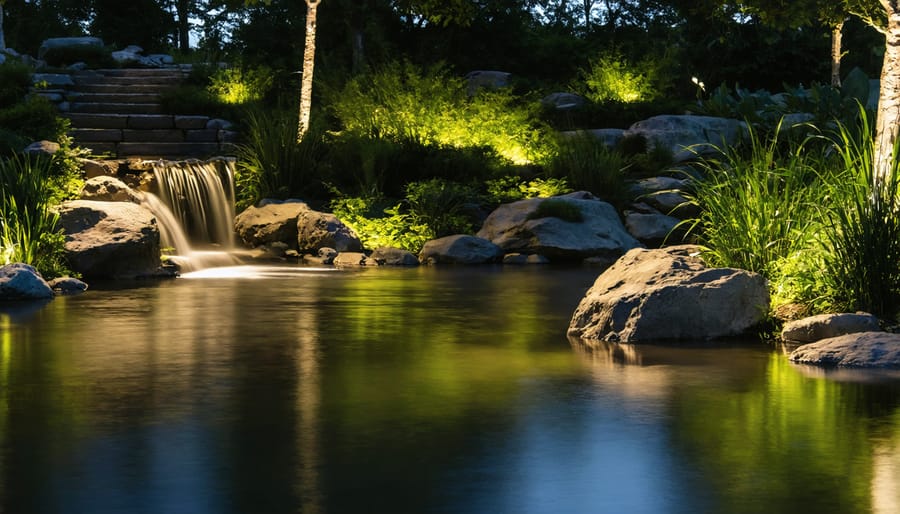
Timing Is Everything
Just like your fish appreciate a regular feeding schedule, your pond lighting thrives on consistent timing. I learned this the hard way when I first installed lights and ran them all night—my algae bloomed like crazy, and my electric bill wasn’t too happy either!
The sweet spot for most ponds is 6-8 hours of artificial light in the evening. This mimics natural daylight duration without overwhelming your ecosystem. A basic timer is your best friend here, and they’re super affordable at any hardware store. Set your lights to turn on at dusk and shut off around midnight—this gives you enjoyable evening viewing without disrupting your pond’s natural rhythms.
Here’s something really cool: seasonal adjustments matter more than you might think. In summer, you can extend lighting to 8 hours when plants are actively growing. Come winter, dial it back to 4-6 hours as your pond slows down. Some advanced timers even adjust automatically based on sunrise and sunset times.
Want to get fancy? Moonlight simulation features create a gentle blue glow that looks magical and helps nocturnal creatures navigate. It’s dimmer than regular lighting, so it won’t fuel algae growth but adds enchanting ambiance to late-night pondside visits.
Creating Balance: Your Action Plan
Reading Your Pond’s Health Signals
Your pond constantly communicates with you through five key health signals that tell you whether your lighting choices are working in harmony with your ecosystem.
Start with water clarity. Crystal-clear water isn’t always the goal—slightly tea-colored water is often perfectly healthy! But if your water suddenly looks murky or green, that’s your pond saying the lighting balance is off. Too much light can trigger algae blooms that cloud everything up. When I first added underwater lights to my pond, I didn’t realize they were encouraging algae growth until the water turned pea-soup green within weeks.
Next, check your algae levels. A thin film on rocks is normal and actually beneficial, but thick mats of string algae or floating green clumps mean you’ve got excess nutrients combined with too much light exposure. Walk around your pond at different times of day to see where sunlight hits hardest.
Observe your plant growth patterns. Healthy aquatic plants should grow steadily but not explosively. If your lilies are sparse and struggling, they might need more light. If they’re taking over like triffids, you may have too much.
Watch your fish behavior closely. Fish gasping at the surface, especially in the morning, signals low oxygen levels—often caused by excessive plant die-off from lighting imbalances. Healthy fish should swim actively throughout different pond depths.
Finally, invest in a simple dissolved oxygen test kit. Oxygen levels fluctuate throughout the day based on plant photosynthesis, which is directly controlled by light availability. Testing at dawn and dusk gives you the complete picture.
Making Adjustments Without Starting Over
The good news? You don’t need to tear everything down and start fresh if your lighting isn’t quite working with your pond’s ecology. I learned this the hard way after installing overly bright fixtures that turned my water pea-soup green within weeks!
Start simple. If algae is taking over, try adding a timer to reduce lighting hours gradually. Cut back an hour at a time and watch how your pond responds over the next week. You might be surprised how much difference even small adjustments make.
Consider swapping to lower wattage bulbs or cooler color temperatures if warmth is fueling algae growth. Moving fixtures further from the water surface also helps by reducing light penetration without eliminating the visual appeal you’re after.
Nature offers built-in solutions too. Adding floating plants like water lettuce or lily pads creates natural shade zones, giving fish refuge while limiting light exposure in problem areas. Position these strategically around bright spots.
Test your water weekly during adjustment periods. Track pH, ammonia, and nitrate levels to see how changes affect your pond’s chemistry. This incremental approach lets you fine-tune without guessing, creating a balanced ecosystem where lighting enhances rather than disrupts your pond’s natural harmony. Small tweaks often yield the biggest improvements.
Here’s the wonderful news: you don’t have to choose between a beautifully illuminated pond and a thriving ecosystem. Finding that sweet spot is absolutely possible once you understand how your pond’s ecology works. Think of it like learning to ride a bike—once you grasp the balance, everything clicks into place.
Understanding pond ecology truly makes you a better pond keeper. When you know how light affects algae growth, fish behavior, and plant health, you’re making informed decisions rather than just guessing. I remember when I first started paying attention to these connections in my own pond. Suddenly, those mysterious algae blooms made sense, and I could actually prevent them instead of constantly reacting to problems.
The beauty of pond keeping is that every pond is unique. Your local climate, the plants you’ve chosen, your fish population, and even the trees nearby all create a one-of-a-kind ecosystem. This means there’s no single perfect lighting formula that works for everyone. What works brilliantly in my shaded backyard pond might need adjusting for your sunny spot.
So here’s my invitation to you: become a pond observer. Experiment with different lighting schedules. Notice how your fish respond. Watch what happens to your water clarity. Keep mental notes about which lights attract the most insects. Your pond will teach you everything you need to know if you’re willing to pay attention. Trust yourself, stay curious, and enjoy the journey of creating your perfect nighttime oasis.
